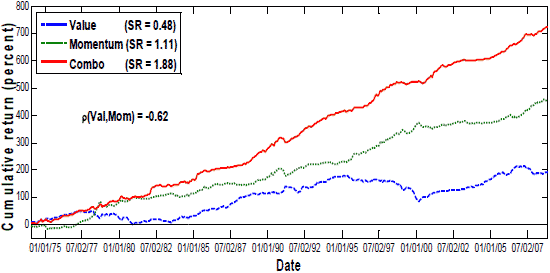The value premium and the momentum effect are arguably complementary drivers of financial asset pricing dynamics, with the latter alternatively creating and extinguishing the former. Does empirical evidence support this view across asset classes? In the February 2009 version of their paper entitled “Value and Momentum Everywhere”, Clifford Asness, Tobias Moskowitz, and Lasse Pedersen investigate the interplay of value and momentum across asset classes worldwide, as follows: (1) stocks within four major countries; (2) country equity indexes; (3) government bonds; (4) currencies; and, (5) commodities. They calculate momentum based on return over the past 12 months, excluding the most recent month, for all asset classes. They estimate value based on measures commonly used for each asset class (such as book-to-market ratio for stocks). Using price and value characteristics data for broad samples of these asset classes, they conclude that:
- Value and momentum both deliver positive abnormal returns across markets and asset classes.
- Value (momentum) in one asset class relates positively to value (momentum) in other asset classes, and value relates negatively to momentum both within and across asset classes.
- The negative correlation between value and momentum returns gives a simple equal-weighted combination of the two a much higher Sharpe ratio and more stability across markets and time periods than either value or momentum alone (see the chart below). In every region, the value-momentum combination exhibits less than half the volatility of either value or momentum.
- A combined value-momentum strategy implemented across all asset classes enhances risk-adjusted returns compared to the same strategy implemented for individual or subgroups of asset classes.
- Over time, value and momentum strategies become less profitable, more positively correlated across markets/asset classes and less negatively correlated with each other.
- Macroeconomic indicators explain very little of the variation in value and momentum returns and return correlations.
- Increasingly over time, value (momentum) strategies weaken (strengthen) when liquidity is poor/declining. A combination of value and momentum in each market therefore provides good diversification against aggregate liquidity risk.
- During extreme events, a more negative correlation between value and momentum returns tends to offset a loss of diversification due to increased correlations for both value returns and momentum returns across markets.
- The strong, opposing turn-of-the-year patterns documented for value and momentum strategies as applied to US equities are not prevalent across markets or asset classes.
The following chart, taken from the paper, compares cumulative returns and annualized Sharpe ratios (SR) for a value strategy, a momentum strategy and a 50-50 value-momentum strategy (rebalanced monthly) as applied to an equal-weighted combination of stock selections from the US, UK, Japan and continental Europe. The benefit of combining the two negatively correlated (-0.62) value and momentum strategies is evident.
The Sharpe ratio for a 50-50 value-momentum strategy limited to US stocks is 1.13, compared to 1.88 as diversified across the four equity markets.

In summary, a portfolio that combines value and momentum strategies across global equity markets and other asset classes may offer investors relatively high returns with low volatility.